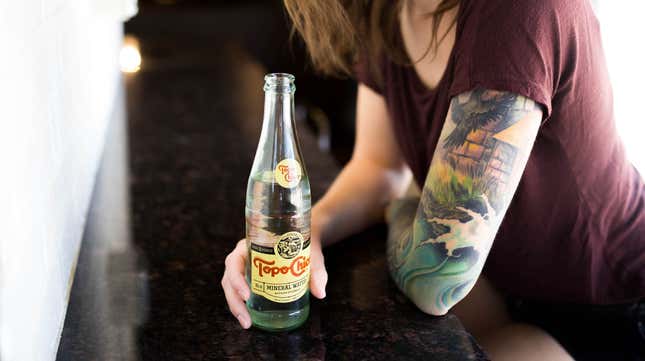
If you, like me, woke up one day in your 30s and decided that seltzer was suddenly your thing, I have some bad news. It’s time to sit down, friend, and mourn yet another thing that this garbage year 2020 has taken from us. As it turns out, a Consumer Reports investigation has found that toxic “forever chemicals” are in several popular bottled water and carbonated water brands.
Per- and polyfluoroakyl substances (PFAS), according to the Environmental Protection Agency, are a group of man-made chemical compounds that don’t easily break down in the environment, or the human body. They’re found in many consumer products, including food packaging, textiles, and nonstick pans, but the most troubling source is drinking water itself.
Your Topo Chico, Bubly, La Croix, and Canada Dry; hell, even your Perrier—all contain levels of PFAS that are higher than the 1 part per trillion (ppt) recommended by scientists and environmental groups. The National Institute of Environmental Health Sciences notes that human exposure to PFAs can result in adverse health effects, including “altered metabolism, fertility, reduced fetal growth, and reduced ability of the immune system to fight infections.”
Meanwhile, a report by the CDC found that PFAs were present in the blood of 97% of Americans. Cool cool cool.
Different regulatory agencies have, surprise surprise, differing cutoffs for what’s an acceptable level of PFAS in water (carbonated or otherwise.) The EPA only has voluntary guidelines for PFAS levels set at 70 ppt for a combination of two of the most studied and dangerous PFAS compounds. Some states have lower limits of 12 to 20 ppt. Meanwhile, the International Bottled Water Association says PFAS levels should be under 5 ppt for one compound and under 10 ppt for more than one compound. However, the investigation emphasized that some experts have said even these “acceptable levels” are too high and that we should really be aiming for less than 1 ppt.
But back to seltzer and bottled water. Consumer Reports tested 47 bottled water brands—35 non-carbonated and 12 carbonated—for four heavy metals and 30 PFAS. Among bottled water brands, Consumer Reports found that most were within acceptable limits for both PFAS and heavy metals. When it came to PFAS, the exceptions were Nestlé’s Deer Park and Tourmaline Spring, which contained 1.21 ppt and 4.64 ppt, respectively. For heavy metals, Whole Foods’ Starkey Spring Water was disturbingly found to have 9.53 ppt of arsenic, which was over three times the recommended limit of 3 ppt.
For carbonated water, all were found to have acceptable levels of heavy metals. However, only Sparkling Ice had undetectable levels of PFAS, while popular brands like Spindrift, Sanpellegrino, Dasani, and Schweppes were all found to be below 1 ppt.
Now here is the more tragic news: Perrier, La Croix, Canada Dry, Poland Spring, Bubly, Polar, and Topo Chico all had levels over the 1 ppt limit. Of all of them, Coca Cola’s Topo Chico was the highest at 9.76 ppt. Polar was second highest at 6.41 ppt. (You can find the entire list here.)
Some of you may be tempted to comment about how much you hate seltzer and that this is a sign that the rest of us should stop being babies and drink regular water like adults. Some may even be former Gizmodo writers with terribly wrong takes. To that, I say, good for you. Have a gold star and let us seltzer drinkers have a whole two seconds to grieve. Soda is bad. Diet soda is also bad. Juice may also be bad and apparently contains harmful levels of arsenic, cadmium, and lead. Some people are yelling that human adults aren’t meant to drink milk. Plant milks are sometimes not great for the environment.
While there is no ethical consumption under capitalism, I thought I had an okay compromise drinking seltzer as an occasional treat for whenever I got sick of guzzling my daily two liters of regular water. Apparently, 2020 won’t let us have anything so I’m going to cross Coconut La Croix off my grocery list. Maybe later I will google how to make infused water. For now, I am going to sit in front of my fridge, blankly stare at my unopened seltzer cans, and wonder how many more meltdowns my shriveled husk can handle this week.